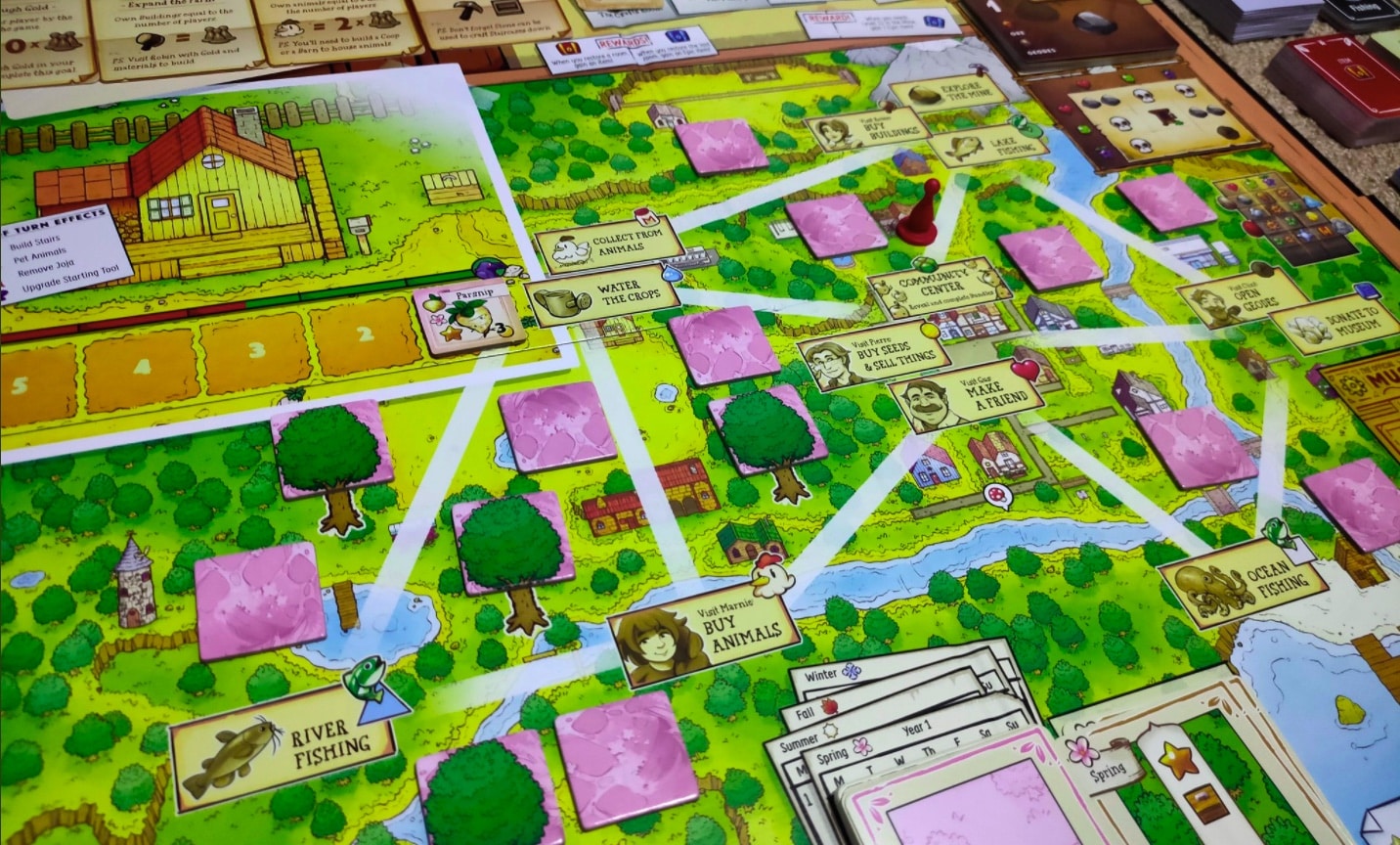There are so many reasons why Stardew Valley became the major success that it is today. From its cute aesthetic to its refined gameplay, plenty of freedom, gorgeous worlds, and a cast of lovely characters, its pure and heartfelt nature shines through in every aspect of play. Stardew Valley: The Board Game, a tabletop adaptation of the beloved title, manages to replicate this same sense of wholesomeness and fun with a well-designed spin on the intricate life sim formula.
Translating Stardew Valley to tabletop sounds like an impossible task. There are so many aspects of the game that rely on video game tropes – upskilling, relationship building and uncovering new worlds. But Stardew Valley: The Board Game effectively skirts the need for a digital component by breaking down Stardew‘s many activities into linear ‘actions’ you can take each turn.
You fulfil the same role in the board game adaptation as you do in the video game; you’re required to build a thriving farm with crops and animal produce, build new locations, defeat the monsters lurking in the nearby caves, make friends, complete important requests, and fill each Community Center bundle to please the Junimos and win the game.
Read: The strangest unsolved mysteries and lore in Stardew Valley
The only difference is that the board game comes with time limitations the video game doesn’t – a decision that injects a real sense of strategy and engagement into this tabletop adaptation.
Stardew Valley: The Board Game – Setup
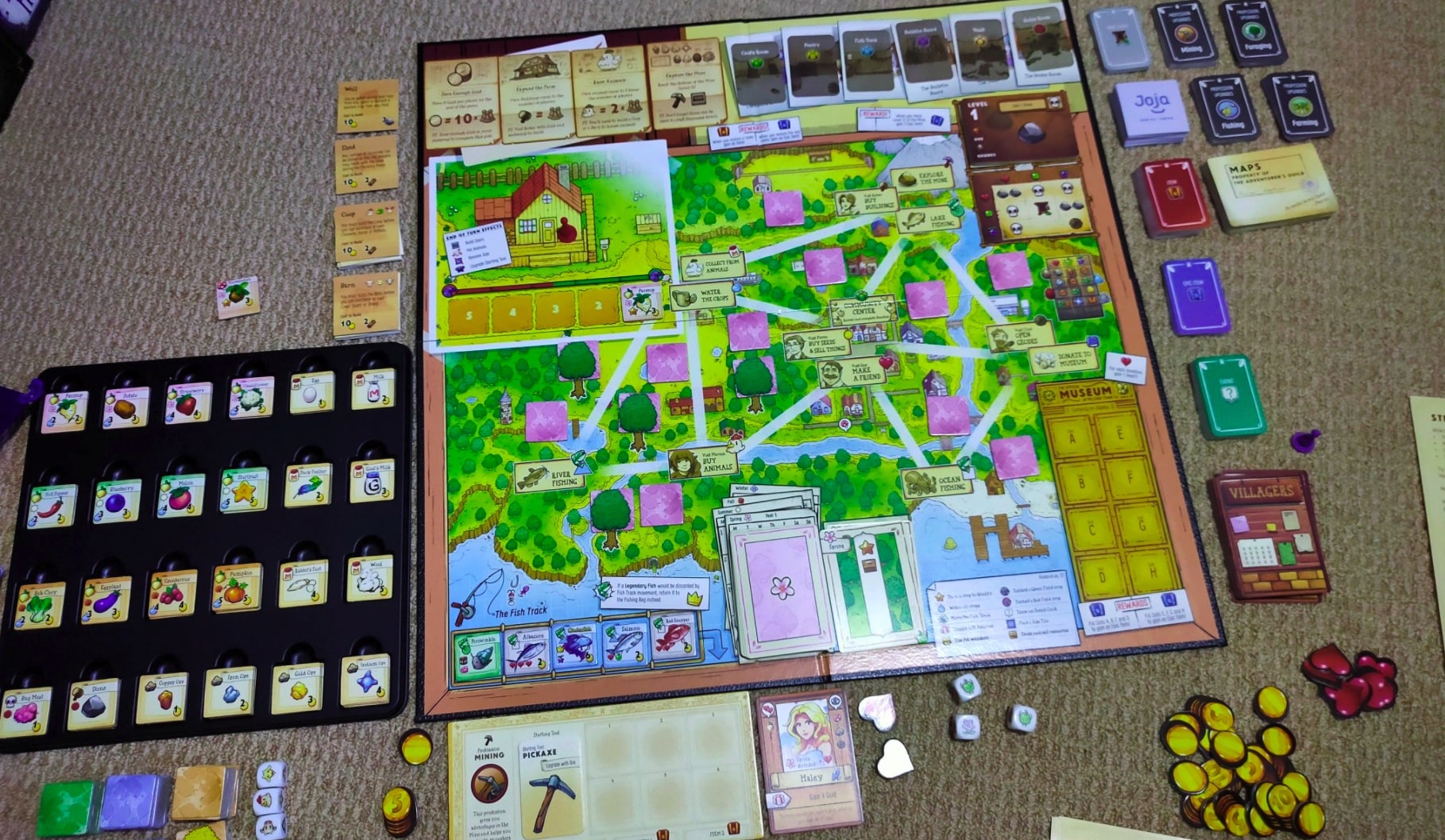
Stardew Valley: The Board Game does require a hefty amount of setup and learning time before you actually get into the real meat of gameplay.
The rulebook is a meaty 20-page tome, and will likely take an hour or so to internalise – though the instructions are written very clearly and the linear gameplay is easy to understand. But what will take the most time is setting up your tabletop for one or more players.
Stardew Valley is packed with cards, items, tokens and coins, with each serving a unique purpose during gameplay. Even for a casual game, you’ll need to complete the full setup pictured above – item cards go in the ‘inventory’ tray, event, item and friend cards and other items are laid out by the board, profession cards need to be set, and both goals and bundles need to be randomly chosen to determine the win state of the game.
A season deck will also need to be organised – each round is determined by season cards which contain new events and happenings per round. The board will also be decorated with season-specific forageables and trees to mark the passing of time.
A step-by-step guide in the rulebook will help you get setup, but a dash of patience will be needed for all of Stardew Valley’s finicky little pieces.
Once this setup is complete and the linear flow of gameplay is understood, it’s a simple matter of diving in, either solo or with friends.
Stardew Valley: The Board Game – Gameplay
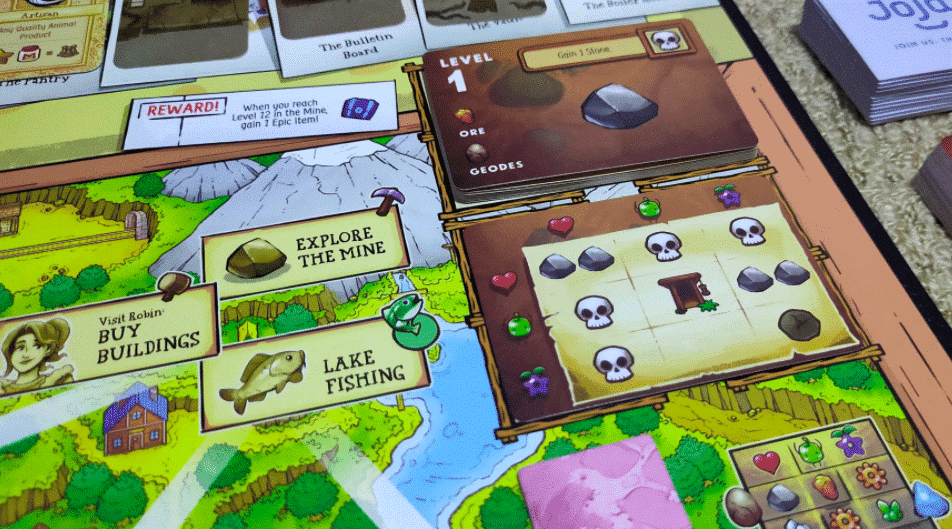
To kick off the action, 1-4 players choose a player board each that determines their skill proficiencies – farming, fishing, foraging, or mining. They choose their starting tool, which can provide benefits during gameplay, and then they set off on their first round.
The ultimate goal of the game is to complete four Grandpa’s Goals (drawn randomly from the deck) and to reveal and complete the Community Center bundles at the top of the board. Custom rules can be set to shake up gameplay, as detailed in the handy rulebook.
Player rounds proceed as follows:
- First, players flip a season card (20 make up the entire ‘year’ of gameplay) and complete the events specified – rain boosts crops, crow steals crops, crops become quality, etc.
- If playing in a group, players will then chat and discuss strategy, including the best path to completing in-game goals – if playing solo, this round is skipped
- Players then take actions – either two in the same map location, or one action / one move to another location / then another action – if players move, they may pick up a forageable item in their path (wood, stone, flowers)
- At the end of each turn, a player may implement one of several ‘end of turn’ effects, which can be very useful
Actions players can take per round include:
- Watering crops to grow them for sale
- Collecting produce from animals to sell
- Exploring the mine
- Buying buildings
- Buying animals
- Donating to the museum to earn heart points
- Opening geodes
- Buying and planting seeds
- Making friends
- Revealing and donating to bundles
- Going fishing
But while players can technically pick any activity and pursue their own goals – making the most money, catching the most fish, having the most buildings – there are select goals that need to be fulfilled, as laid out in the setup round.
Grandpa’s Goals will typically ask players to ‘perfect’ one of the action skills – travelling to the bottom of the mine, earning a set amount of collective money, having a number of farm buildings, or having a number of animals. These goals tend to multiply based on player count, so the difficulty will effectively fluctuate based on your playing group.
Stardew Valley: The Board Game – Solo Mode Verdict
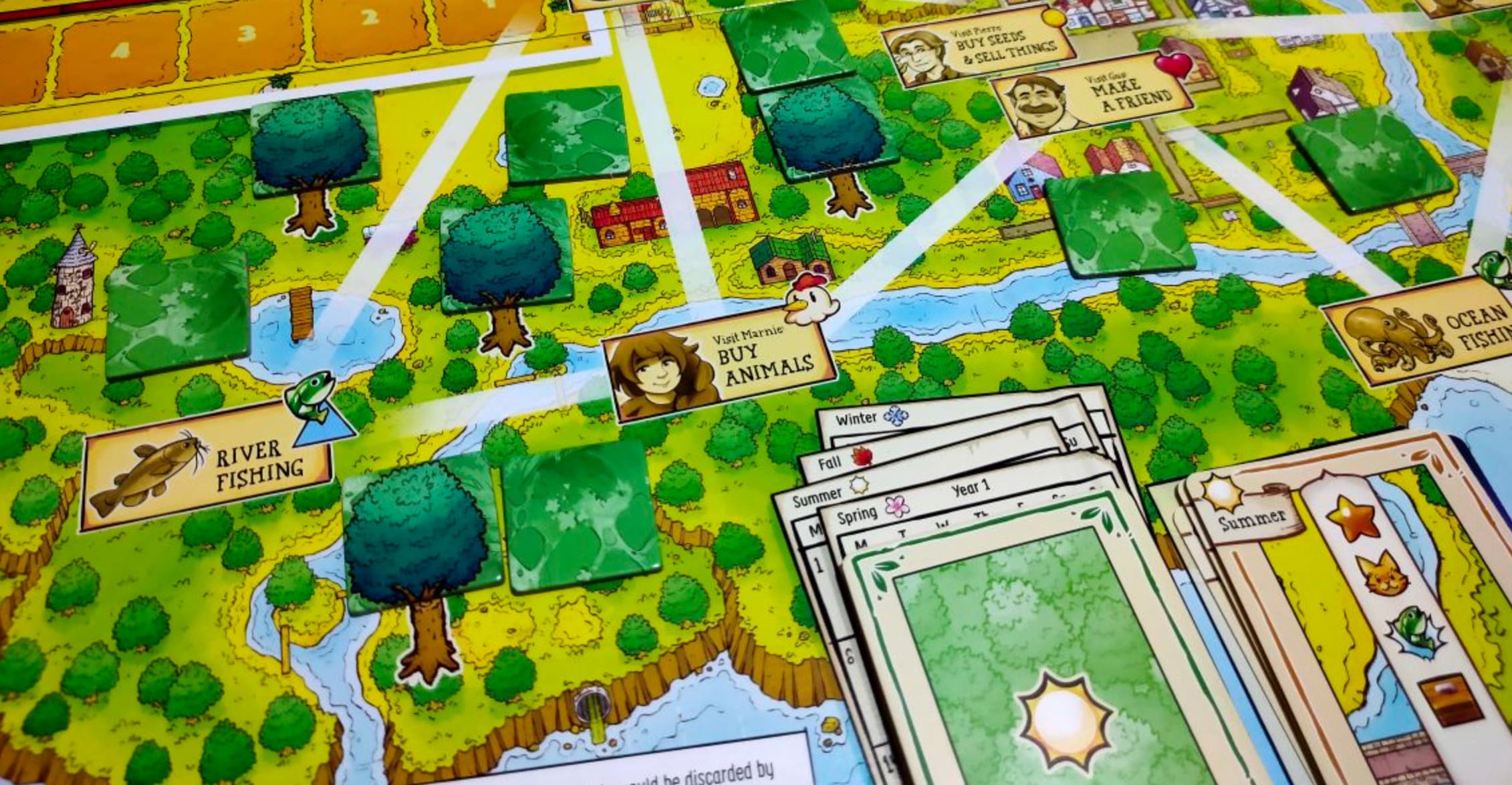
Stardew Valley: The Board Game‘s linear action is genuinely excellent. While the basic mechanics are simple and easy to understand, the addition of timed goals means you need to make active, strategic choices about where your character’s actions will take place, and how much time you should spend in each location. There’s a sense of weight to every choice, and this will guide you along a frantic path to the win or lose state.
Taking time to make friends can provide major boosts – some give you extra coins every time a ‘gift’ event is activated by a season card. Some can double your earnings. But you need to spend an action to uncover a friend – and you may not be able to keep them if you don’t have items they like in your inventory.
It’s a risk, but Stardew Valley: The Board Game encourages those risks, with luck playing a minor (but notable) role in your overall success.
The interlocking systems, and how they all serve the ultimate Grandpa’s Goals or Community Center bundle achievements, makes choice and forward-thinking an essential part of the game. While you may be distracted by the incredibly cute animals and overall aesthetic, or the many items you can collect, gameplay is tight and requires tough, mindful decisions.
If you spend too long hacking away at a level in the mine, you may miss out on earning the gold you need to purchase chickens or buildings. If you don’t spend time fishing, you won’t be able to pick up the much-needed wood forageables. Gameplay is all about balance, and taking the time to assess the entirety of the board, and every potential move you can make.
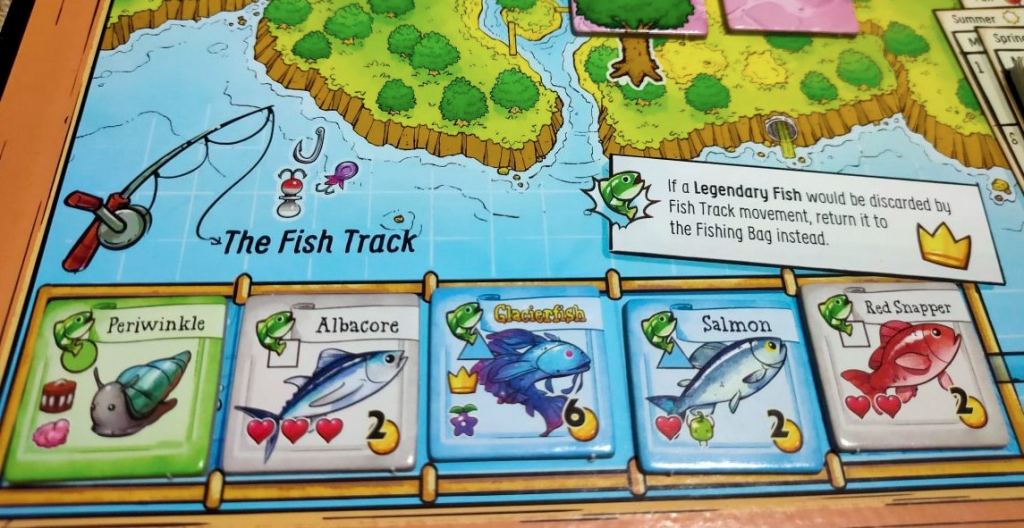
As each season passes and time gets shorter, you’ll really need to rush your way to the finish – and if you’ve wasted turns or ignored goals, you may find yourself in a mad dash to the end. But no matter how you get to the game’s year end, whether you win or lose, the game remains extremely pleasant and engaging throughout.
Between its art and mechanics, it’s a very fetching package – and one that’ll certainly appeal to fans of the video game, or fans of RPGs in general. There’s a real sense of satisfaction to be had in carefully picking your actions each round, and watching as the game board changes with every season.
While it skips some of the finer parts of Stardew Valley – combat takes a back seat to exploration – the spirit and heart of the game is certainly here, in every season, and every unique action you can take.
Playing the game solo doesn’t take away from this fun – instead, it speeds up the action by removing the ‘discussion’ round and reducing the toll for bundles. While it does remove the potential for multiple ‘end of turn’ effects, and makes climbing through the mine a little harder as a result, the game is clearly designed with choice and gameplay freedom in mind. It’s also designed to be consistently exciting, no matter how many times you play.
Each item reveal, mine event or tile flip reveals something fresh and new, making rounds a surprise no matter which way you play. And with so much choice – in goals, in seasonal events, in actions to take – it’s a board game that feels like it has just as much longevity as its video game source material.
Against all odds, Stardew Valley: The Board Game has managed to successfully replicate the winning Stardew formula in a board game that’s perfect for all ages, and one that remains consistently surprising with every tile flip and fresh round. There’s pure joy to be found here, and surprises in every beautifully-illustrated locale.
Five stars: ★★★★★
Stardew Valley: The Board Game
Designers: Eric Barone, Cole Medeiros
Publisher: ConcernedApe
Release Date: 2021
A copy of Stardew Valley: The Board Game was purchased and played for the purpose of this review.
